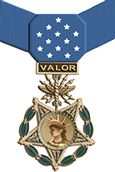


Personal Information


Medals and Awards
![]() Medal of Honor
Medal of Honor
![]() Distinguished Flying Cross
Distinguished Flying Cross
![]() Air Medal
Air Medal
![]() Air Force Commendation Medal
Air Force Commendation Medal
Memorials
A marker has been placed outside the courthouse in his hometown of Newnan, Georgia
Copyright 2013 Hilliard A Wilbanks Foundation










































